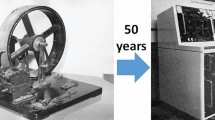Abstract
In this work, we show a new procedure to obtain an optimum DC polarisation potential that allows achieving the maximum possible sensitivity for analyte determination, when electrochemical techniques are used. This is valid whether purely DC or AC potentials are used for system polarisation. In addition, the optimum potential is lower than the ones generally used by the classical methods, avoiding redox-active interferents and rapid degradation of the working electrode. In our case, we obtain a reduction of 16% of the DC applied potential and an increase among 3 and 5 times in the sensitivity.
Graphical abstract








Similar content being viewed by others
References
Suni II (2008) Impedance methods for electrochemical sensors using nanomaterials. TrAC, Trends Anal Chem 27:604–611. https://doi.org/10.1016/j.trac.2008.03.012
Chang BY, Park SM (2010) Electrochemical impedance spectroscopy. Annu Rev Anal Chem 3:207–229. https://doi.org/10.1146/annurev.anchem.012809.102211
Sharafeldin M, Bishop GW, Bhakta S, El-Sawy A, Suib SL, Rusling JF (2017) Fe3O4 nanoparticles on graphene oxide sheets for isolation and ultrasensitive amperometric detection of cancer biomarker proteins. Biosens Bioelectron 91:359–366. https://doi.org/10.1016/j.bios.2016.12.052
Stefano JS, Rocha DP, Dornellas RM, Narciso LC, Krzyzaniak SR, Mello PA, Munoz RA (2017) Highly sensitive amperometric detection of drugs and antioxidants on non-functionalized multi-walled carbon nanotubes: effect of metallic impurities? Electrochim Acta 240:80–89. https://doi.org/10.1016/j.electacta.2017.04.050
Ostojić J, Herenda S, Bešić Z, Miloš M, Galić B (2017) Advantages of an electrochemical method compared to the spectrophotometric kinetic study of peroxidase inhibition by boroxine derivative. Molecules 22:1120–1128. https://doi.org/10.3390/molecules22071120
Liu G, Lin Y (2006) Biosensor based on self-assembling acetylcholinesterase on carbon nanotubes for flow injection/amperometric detection of organophosphate pesticides and nerve agents. Anal Chem 78:835–843. https://doi.org/10.1021/ac051559q
Martinez CCM, Treo EF, Madrid RE, Felice CC (2010) Evaluation of chrono-impedance technique as transduction method for a carbon paste/glucose oxidase (CP/GOx) based glucose biosensor. Biosens Bioelectron 26:1239–1244. https://doi.org/10.1016/j.bios.2010.06.033
Martinez CCM, Treo EF, Madrid RE, Felice CC (2011) Real-time measurement of glucose using chrono-impedance technique on a second generation biosensor. Biosens Bioelectron 29:200–203. https://doi.org/10.1016/j.bios.2011.08.018
Wang J, Luck LA, Suni II (2007) Immobilization of the glucose-galactose receptor protein onto a Au electrode through a genetically engineered cysteine residue. Electrochem Solid-State Lett 10:J33–J36. https://doi.org/10.1149/1.2404021
Radhakrishnan R, Suni II, Bever CS, Hammock BD (2014) Impedance biosensors: applications to sustainability and remaining technical challenges. ACS Sustain Chem Eng 2:1649–1655. https://doi.org/10.1021/sc500106y
Elshafey R, Radi AE (2018) Electrochemical impedance sensor for herbicide alachlor based on imprinted polymer receptor. J Electroanal Chem 813:171–177. https://doi.org/10.1016/j.jelechem.2018.02.036
N. A. Batrisya Ismail, F. Abd-Wahab, W. W. Amani Wan Salim (2018) Cyclic voltammetry and electrochemical impedance spectroscopy of partially reduced graphene oxide—PEDOT:PSS Transducer for Biochemical Sensing. In: 2018 IEEE-EMBS conference on biomedical engineering and sciences (IECBES), Sarawak, Malaysia, pp 330–335. https://doi.org/10.1109/IECBES.2018.8626618
Park J, Lee W, Kim I, Kim M, Jo S, Kim W, Park H, Lee G, Choi W, Yoon DS, Park J (2019) Ultrasensitive detection of fibrinogen using erythrocyte membrane draped electrochemical impedance biosensor. Sens Actuators B Chem 293:296–303. https://doi.org/10.1016/j.snb.2019.05.016
Narakathu BB, Atashbar MZ, Bejcek BE (2010) Improved detection limits of toxic biochemical species based on impedance measurements in electrochemical biosensors. Biosens Bioelectron 26:923–928. https://doi.org/10.1016/j.bios.2010.06.051
Madrid RE, Treo EF, Herrera MC, Mayorga Martinez CC (2010) Handbook of physics in medicine and biology. Robert Splinter, Boca Raton
Ruiz GA, Felice CJ (2015) Electrochemical-fractal model versus randles model: a discussion about diffusion process. Int J Electrochem Sci 10:8484–8496
Wiese H, Greef R, Peat R, Peter LM, Pletcher D, Robinson J (1986) Instrumental methods in electrochemistry. Ber Bunsenges Phys Chem 90:559–559. https://doi.org/10.1002/bbpc.19860900614
Nicholson RS (1966) Semiempirical procedure for measuring with stationary electrode polarography rates of chemical reactions involving the product of electron transfer. Anal Chem 38:1406–1406. https://doi.org/10.1021/ac60242a030
Ruiz GA, Felice CJ (2021) Low error Kramers-Kronig estimations using symmetric extrapolation method. J Electr Bioimp 12:147–152. https://doi.org/10.2478/joeb-2021-0017
Sevcik A (1948) Oscillographic polarography with periodical triangular voltage. Collect Czech Chem Commun 13:349–377. https://doi.org/10.1135/cccc19480349
Delahay P (1954) New instrumental methods in electrochemistry. Interscience Publishers Inc., New York
Acknowledgements
This work has been supported by Grants from Agencia Nacional de Promoción Científica y Tecnológica (ANPCYT) (PICT 2565 2016), Consejo Nacional de Investigaciones Científicas y Técnicas (CONICET) (PIP CONICET 112-20150100842), and Consejo de Investigaciones de la Universidad Nacional de Tucumán (CIUNT), as well as by Institutional funds from Instituto Superior de Investigaciones Biológicas (INSIBIO).
Author information
Authors and Affiliations
Contributions
GAR and CJF made the conceptualization, methodology, data curation, writing and supervision. LS: performed experiments and validation. PN,MZ,CG: made data validation and writing RM: Only validation
Corresponding author
Ethics declarations
Competing interests
The authors declare no competing interests.
Additional information
Publisher's Note
Springer Nature remains neutral with regard to jurisdictional claims in published maps and institutional affiliations.
Supplementary Information
Below is the link to the electronic supplementary material.
Rights and permissions
Springer Nature or its licensor (e.g. a society or other partner) holds exclusive rights to this article under a publishing agreement with the author(s) or other rightsholder(s); author self-archiving of the accepted manuscript version of this article is solely governed by the terms of such publishing agreement and applicable law.
About this article
Cite this article
Felice, C.J., Ruiz, G.A., Saad, L. et al. A new method for optimising polarisation point in electrochemical impedance based measurements. J Appl Electrochem 53, 1787–1793 (2023). https://doi.org/10.1007/s10800-023-01879-y
Received:
Accepted:
Published:
Issue Date:
DOI: https://doi.org/10.1007/s10800-023-01879-y




